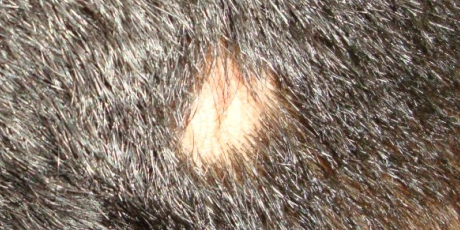Medical Evidence | Causes | Role of immune system
Alopecia areata – an autoimmune condition causing hair loss – can occur at any age. It can start in children as early as age 3 years. The exact reason why immune system attacks the hair follicles is not known. Genetic features combined with other aspects predispose people to onset of alopecia. If the immune reaction is treated and stopped, hair follicles become normal and return to normal hair production as usual.
Medical evidence
Current medical evidence shows the culprit to be the immune system. This mistakenly treats the hair follicles as foreign objects and attacks them causing a mild inflammation. This weakens the hair follicles which fall out causing bald patches. Biopsy of bald scalp shows presence of immune lymphocytes in hair follicles. These lymphocytes mix up the growth cycle routine of the normal hair causing hair loss. People with alopecia have abnormal color, shape, texture, or thickness of the fingernails or toenails.
Causes
There is no known reason why autoimmune diseases including alopecia areata occur. Possible triggers that set up the immune system to go amuck are hypothesized to be
- Infection.
- Viruses.
- Some medicines.
- A few environmental factors – though not exactly understood.
- Family history – High frequency of positive family history in affected patients.
- Genetic factors – More than a single gene causes alopecia areata; it is likely that it is caused by polygenic defects. But at least 25% of alopecia areata patients have a close relative with alopecia.
- Association with other autoimmune diseases.
- Stress – mental stress can be a trigger for people already pre-susceptible to alopecia.
Role of immune system
There is a link between alopecia areata occurrence and other autoimmune diseases like
- Thyroid disease.
- Lupus.
- Rheumatoid arthritis.
- Allergies.
- Addison’s disease
- Chemicals called cytokines which form part of immune system and inhibit hair follicle growth causing alopecia areata.
- Alopecia predisposes patients for developing autoimmune diseases like asthma, vitiligo, thyroid disorders and pernicious anemia,Systemic lupus erythematosus,ulcerative colitis,diabetes mellitus,and others.
Outlook
Alopecia areata’s progress is highly unpredictable. The severity also varies from patient to patient. It cannot be predicted which areas of the scalp will be affected and when they will re-grow. But there are many cases of spontaneous hair re-growth without any medication or treatment. There are several treatment options available that are topical, oral and injectible medications. When you are awaiting hair re-growth, you can use cosmetic enhancements like wigs temporarily.
-
- American academy of Dermatology – Alopecia areata: Who gets and causes view
- MedicineNet – About Alopecia view
- Patient.co.uk (Original Author: Dr Tim Kenny) view
- National Institue of Health – Questions and Answers about Alopecia Areata view
- Dermatology – About.com (Heather Brannon, MD) view
- Medscape – Drugs, Diseases and Procedures [Alopecia Areata – Author: Chantal Bolduc, MD, FRCP(C); Chief Editor: Dirk M Elston, MD] view


 Dr. Batul Patel is a celebrity dermatologist and the medical director of The Bombay Skin Clinic an award winning clinic located in South Mumbai & Bandra. She is a passionate and dedicated dermatologist with expertise in all fields of dermatology, trichology and aesthetic dermatology. She has been practicing for more than a decade. Her range of expertise include emsculpt NEO, coolsculpting, fillers, acne treatment, lasers, skin rejuvenation, hair loss, hair transplant, PRP & pigmentation treatments.
Dr. Batul Patel is a celebrity dermatologist and the medical director of The Bombay Skin Clinic an award winning clinic located in South Mumbai & Bandra. She is a passionate and dedicated dermatologist with expertise in all fields of dermatology, trichology and aesthetic dermatology. She has been practicing for more than a decade. Her range of expertise include emsculpt NEO, coolsculpting, fillers, acne treatment, lasers, skin rejuvenation, hair loss, hair transplant, PRP & pigmentation treatments.